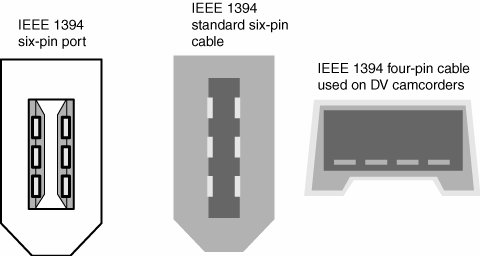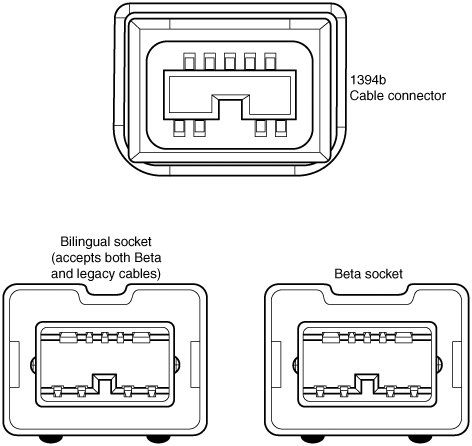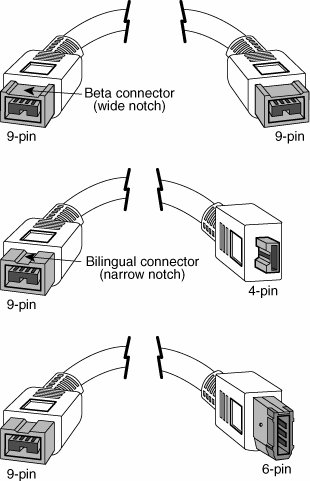IEEE 1394
| The Institute of Electrical and Electronic Engineers Standards Board introduced IEEE 1394 (or just 1394 for short) in late 1995. The number comes from the fact that this happened to be the 1,394th standard they published. It is the result of the large data-moving demands of today's audio and video multimedia devices. The key advantage of 1394 is that it's extremely fast; the popular 1394a standard supports data transfer rates up to an incredible 400Mbps. 1394 StandardsThe most common version of the 1394 standard is actually referred to as 1394a, or sometimes as 1394a-2000 for the year it was adopted. The 1394a standard was introduced to solve interoperability and compatibility issues in the original 1394 standard; it uses the same connectors and supports the same speeds as the original 1394 standard. The first products to use the 1394b standard were introduced in early 2003. Initially, 1394b supports 800Mbps transfer rates, but future versions of the standard might reach speeds of up to 3,200Mbps. 1394b will be capable of reaching much higher speeds than the current 1394/1394a standard because it will also support network technologies such as glass and plastic fiber-optic cable and Category 5 UTP cable, increased distances when Category 5 cabling is used between devices, and improvements in signaling. 1394b will also be fully backward-compatible with 1394a devices. 1394 is also known by two other common names: i.LINK and FireWire. i.LINK is an IEEE 1394 designation initiated by Sony in an effort to put a more user-friendly name on IEEE 1394 technology. Most companies that produce 1394 products for PCs have endorsed this new name initiative. Originally, the term FireWire was an Apple-specific trademark that Apple licensed to vendors on a fee basis. However, in May 2002, Apple and the 1394 Trade Association announced an agreement to allow the trade association to provide no-fee licenses for the FireWire trademark on 1394-compliant products that pass the trade association's tests. Apple continues to use FireWire as its marketing term for IEEE 1394 devices. FireWire 400 refers to Apple's IEEE 1394acompliant products, whereas FireWire 800 refers to Apple's IEEE 1394bcompliant products. 1394a Technical DetailsThe IEEE 1394a standard currently exists with three signaling rates100Mbps, 200Mbps, and 400Mbps (12.5MBps, 25MBps, and 50MBps). Most PC adapter cards support the 400Mbps (50MBps) rate, although device speeds can vary. A maximum of 63 devices can be connected to a single IEEE 1394 adapter card by way of daisy-chaining or branching. 1394 devices, unlike USB devices, can be used in a daisy-chain without using a hub, although hubs are recommended for devices that will be hot-swapped. Cables for IEEE 1394/1394a devices use Nintendo GameBoyderived connectors and consist of six conductors: Four wires transmit data, and two wires conduct power. Connection with the motherboard is made either by a dedicated IEEE 1394 interface or by a PCI adapter card. Figure 15.9 shows the 1394/1394a cable, socket, and connector. Figure 15.9. IEEE 1394 port, 6-pin cable, and 4-pin cable. The 1394 bus was derived from the FireWire bus originally developed by Apple and Texas Instruments, and it is also a part of a new Serial SCSI standard. 1394a uses a simple six-wire cable with two differential pairs of clock and data lines, plus two power lines; the four-wire cable end shown in Figure 15.9 is used with self-powered devices, such as DV camcorders. Just as with USB, 1394 is fully PnP, including the capability for hot-plugging (insertion and removal of components without powering down). Unlike the much more complicated parallel SCSI bus, 1394 does not require complicated termination, and devices connected to the bus can draw up to 1.5 amps of electrical power. 1394 offers equal or greater performance compared to ultra-wide SCSI, with a much less expensive and less complicated connection. 1394 is built on a daisy-chained and branched topology, and it allows up to 63 nodes, with a chain of up to 16 devices on each node. If this is not enough, the standard also calls for up to 1,023 bridged buses, which can interconnect more than 64,000 nodes! Additionally, as with SCSI, 1394 can support devices with various data rates on the same bus. Most 1394 adapters have three nodes, each of which can support 16 devices in a daisy-chain arrangement. Some 1394 adapters also support internal 1394 devices. The types of devices that can be connected to the PC via 1394 mainly include video cameras; editing equipment; and all forms of disk drives, including hard disk, optical, floppy, CD-ROM, and DVD-ROM drives. Also, digital cameras, tape drives, high-resolution scanners, and many other high-speed peripherals that feature 1394 have interfaces built in. The 1394 bus appears in some desktop and portable computers as a replacement or supplement for other external high-speed buses, such as USB or SCSI. Chipsets and PCI adapters for the 1394 bus are available from a number of manufacturers, including some models that support both 1394 and other port types in a single slot. Microsoft has developed drivers to support 1394 in Windows 9x and later, including Windows XP. The most popular devices that conform to the IEEE 1394 standard are camcorders and VCRs with digital video capability. Sony was among the first to release such devices (under the i.LINK name). In typical Sony fashion, however, its products have a unique four-wire connector that requires an adapter cord to be used with IEEE 1394 PC Cards, and Sony doesn't even call it IEEE 1394 or FireWireit created its own designation (i.LINK) instead. DV products using 1394 also are available from Panasonic, Sharp, JVC, and others. Noncomputer IEEE 1394 applications include DV conferencing devices, satellite audio and video data streams, audio synthesizers, DVD, and other high-speed disc drives. Because of the current DV emphasis for IEEE 1394 peripherals, many FireWire cards currently offered are bundled with DV capturing and editing software. With a DV camera or recording equipment, these items provide substantial video editing and dubbing capabilities on your PC. Of course, you need IEEE 1394 I/O connectivity, which is a growing, but still somewhat rare, feature on current motherboards. IEEE 1394b Technical DetailsIEEE 1394b is the second generation of the 1394 standard, with the first products (high-performance external hard drives) introduced in January 2003. IEEE 1394b uses one of two nine-pin cables and connectors to support speeds of 800Mbps3200Mbps with copper or fiber-optic cabling. In addition to supporting faster transfer rates, 1394b has other features, including
The initial implementations of IEEE 1394b use a nine-wire interface with two pairs of signaling wires. However, to enable a 1394b port to connect to 1394a-compatible devices, there are two different versions of the 1394b port:
Beta connectors support only 1394b devices, whereas bilingual connectors can support both 1394b and 1394a devices. As Figure 15.10 shows, the connectors and cables have the same pinout but are keyed differently. Figure 15.10. Bilingual and beta 1394b connectors and cables. Many 1394b implementations use both types of connectors. Note that bilingual sockets and cables have a narrower notch than beta sockets and cables. This prevents cables designed for 1394a devices from being connected to the beta socket. Figure 15.11 compares a beta-to-beta 1394b cable to bilingual-to-1394a cables. Figure 15.11. A beta-to-beta cable (top) compared to bilingualto4-pin (middle) and bilingualto6-pin 1394a devices (bottom). |
EAN: 2147483647
Pages: 283


